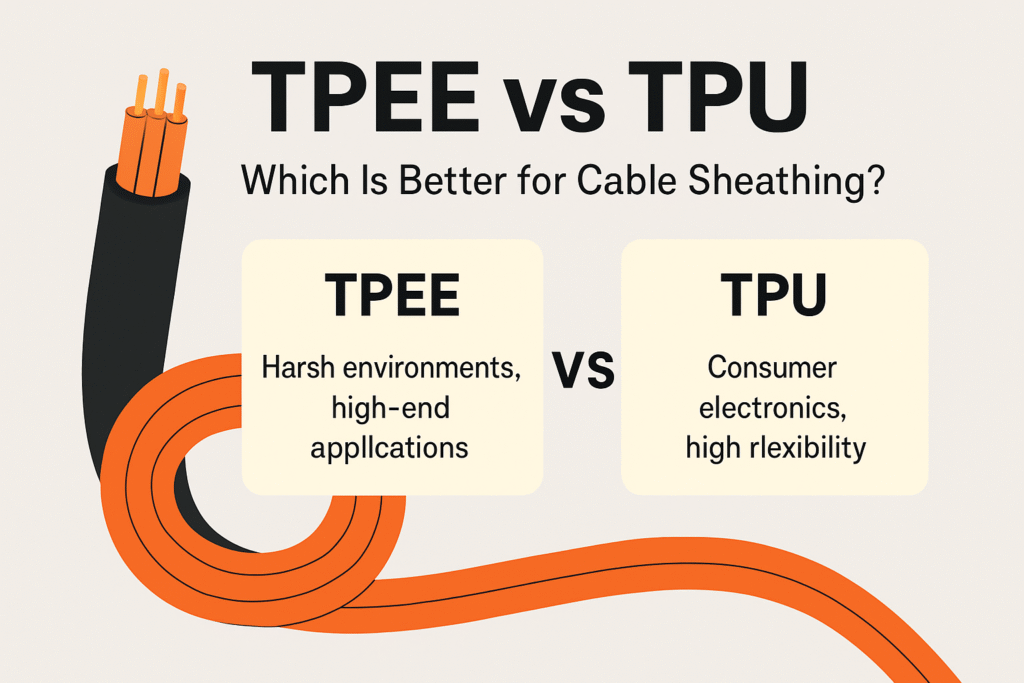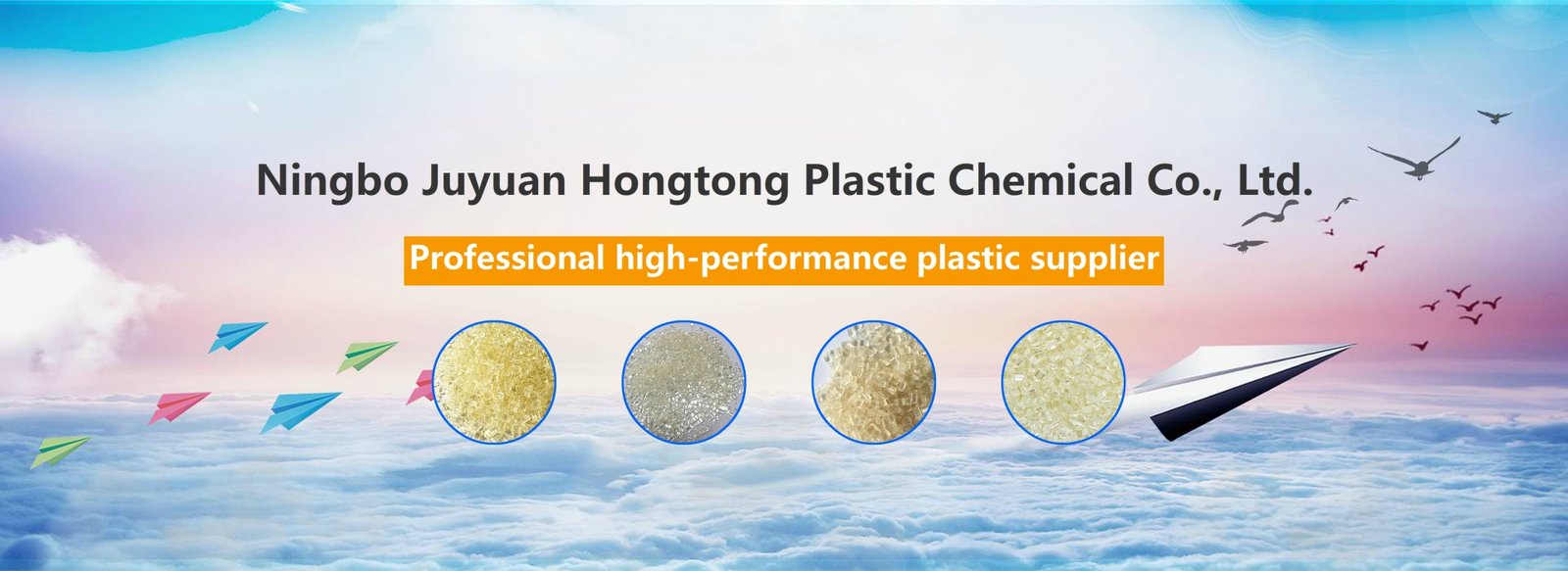TPEE vs TPU
In the rapidly evolving cable manufacturing industry, material selection is no longer just a trade-off between cost and performance, but also a comprehensive judgement of product reliability, environmental regulations and supply chain security. In recent years, with the advancement of new energy, smart home, automotive electrification and other industries, the selection of TPEE (thermoplastic polyester elastomer) y TPU (thermoplastic polyurethane), as the mainstream cable sheathing materials, has once again become a focus of attention for engineers and procurement.

01 | Background: Escalating Challenges for Cable Sheathing
As the market for electric vehicles, smart manufacturing and renewable energy expands, and cable systems are used significantly more frequently in extreme environments, sheathing materials are facing the following real-world challenges:
・Increased oil and chemical resistance requirements (especially for automotive cables)
・The ability to maintain mechanical properties at high temperatures is becoming critical (e.g. industrial robots)
・Outdoor cables must have excellent UV ageing resistance
・Green policies place new demands on material recyclability
These trends are prompting manufacturers to take a fresh look at traditional materials, driving the technological competition between TPEE and TPU as the next generation of sheathing materials.
02 | Performance Comparison: TPEE vs. TPU – Which Is Better for Sheathing Applications?
| Key Properties | TPEE | TPU |
| Recuperación elástica | Superior rebound and long fatigue life | Good, but more prone to aging |
| Oil & Chemical Resistance | Excellent, especially against automotive fluids | Moderado |
| Estabilidad térmica | Withstands up to 140–160°C | Typically limited to 100–120°C |
| UV Resistance | Stronger, ideal for outdoor use | Average, requires additives to enhance |
| Procesabilidad | Easy to extrude/inject mold with stable form | Sensitive to processing temperatures |
| Tactile Softness | Relatively firm | Softer, offers better comfort feel |
| Cost | Higher (material + processing) | Relatively lower |
Conclusión:
・TPEE is better suited for harsh industrial environments and high-end applications such as wiring harnesses for new energy vehicles, high-frequency mobile cables, and outdoor photovoltaic cabling;
・TPU is more suitable for high flexibility requirements, cost control sensitive consumer electronics, such as data cables, headphone cables.
03 | Industry Case Study
・A European and American electric car brand: the original TPU cable sheath will be replaced by TPEE from 2024, the main reason is that TPU is easy to harden and fracture in the high temperature zone of the engine compartment, while TPEE shows stronger thermal stability and fatigue strength.
・A solar energy project in Southeast Asia: Due to the humid and high temperature outdoor environment, TPEE was finally chosen to replace PVC and TPU, which improved the reliability and service life of the system.
04 | Material supply and cost security: TPU is there a hidden danger?
The price of TPU fluctuates relatively frequently due to the source of raw materials and the cost of synthesis, and is susceptible to the influence of polyether/polyester-based raw materials. At a time when the global sourcing chain is becoming increasingly fragile, some end-users have turned to TPEE as a ‘controlled alternative’ to TPU.
In addition, environmental regulations such as the EU RoHS3 and the upcoming implementation of the Chinese GB/T 39560 series of standards, the migratory components in the material put forward higher requirements, TPU if not optimised for the formulation, easy to ‘step on the red line’ in the test.
05 | Selection Suggestions: What scenarios are more suitable for TPEE, and when should TPU be preferred?
Preferred scenarios for TPEE:
・Cables with a long working temperature of ≥125°C or more
・Communication/energy cables with strong illumination and exposure to the outdoors
・High-speed extrusion, applications requiring production efficiency
・Procurement side, when the demand for cost and supply chain stability is high
Suitable scenarios for TPU:
・Short cables for handheld devices, wearable devices, etc. that require high flexibility
・Low-temperature environments for indoor use without contact with oil
・Flexible jackets with special resilience and tensile resistance requirements
06 | Future Trends: Material Upgrades or Combinations?
According to the trend of draft environmental protection regulations in many countries in 2025, TPEE is becoming a plus in large project tenders because of its high recyclability, low VOC emissions and other green attributes. TPU is also competing for the mid-range market through co-modification (e.g. TPU+TPV).
Material selection will no longer be ‘either/or’, but according to different cable segments (indoor, outdoor, engine compartment, bendable parts) combination of TPEE, TPU, and even PA, LSZH composite materials become the new industry practice.
07 | Juyuan Viewpoint: Material Trends from a Trader's Perspective
As a supplier specialising in international trade of plastic raw materials, Juyuan has recently observed:
・As a supplier specialising in international trade of plastic raw materials, Juyuan has recently observed that there has been a significant increase in enquiries for TPEE from customers in India, Malaysia, Poland, etc., with particular attention to models with temperature resistance ≥ 140°C and UV resistance;
・Some brands are shifting from TPU to dual supply line strategy, while keeping TPEE as an alternative material to diversify risks;
・Demand for TPEE materials that ‘can replace TPU and stable supply’ has grown significantly, showing a strong ‘stability first’ procurement mentality.
08 | Choose Juyuan to Achieve Your Material Sourcing Advantage
As a professional international trader of plastic raw materials, Juyuan has been deep-rooted in the industry for more than 20 years, focusing on providing TPEE, TPU and all kinds of engineering plastic pellets, and is committed to bringing our customers:
・Genuine product guarantee - directly sourced from the world's leading brands, quality is guaranteed.
・Abundant inventory supply - fast response to ensure stable delivery, support for multiple batch orders.
・Technical support services - a team of professional material engineers to assist you in accurate selection and process optimisation.
・Global logistics network - Hassle-free delivery, covering Europe, America, Southeast Asia and other key markets
・Personalised Solutions - Recommend the most suitable material models and supporting services for your project needs.
Conclusion: The choice is not only in materials, but also in matching
For cable manufacturers and buyers, material selection is not only a balance between cost and performance, but also a deep fit between product positioning and application environment. TPEE and TPU have their own merits, and only with the combination of specific scenarios, processing technology, project life cycle requirements, can we find the real "right choice! The only way to find the ‘right choice’ is to combine specific scenarios, processing technology and project life cycle requirements.
If you are evaluating TPEE or TPU sheath materials, please contact Juyuan for more material samples and application solutions. We specialize in the international supply of plastic raw materials, helping customers improve product stability and cost efficiency.

